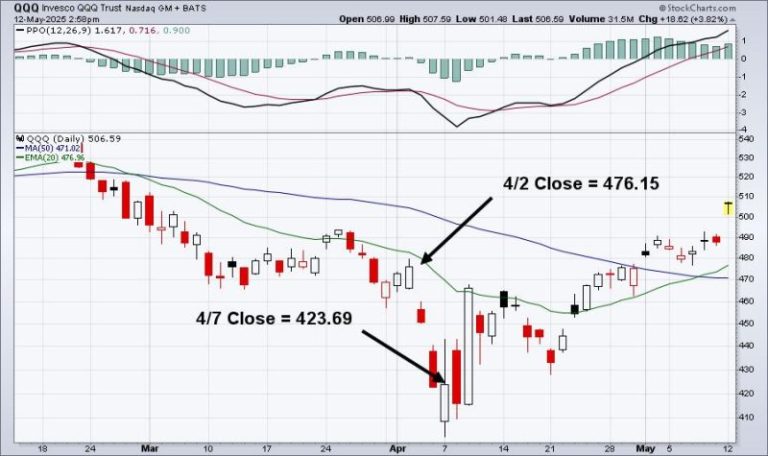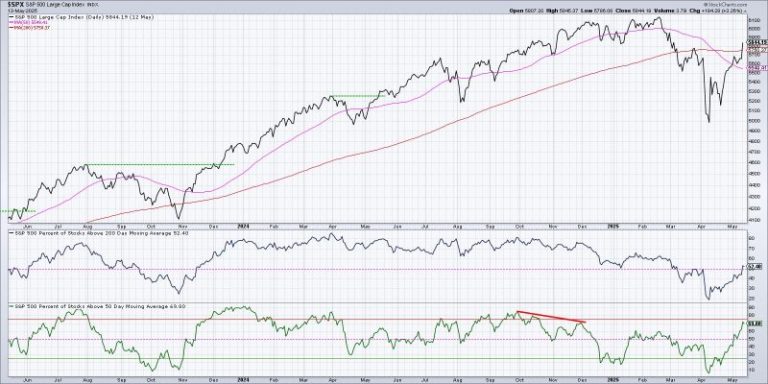Let’s be honest. Did anyone think a little more than a month ago that the S&P 500 was primed for a 1000-point rebound? I turned bullish at that April 7th bottom a month ago, but I did not see this type of massive recovery so quickly.
Why does this happen?
I believe these panicked selloffs occur, because the big Wall Street firms get out prior to market massacres and they need to get back in. What’s the best way to accumulate shares? To send out your best market influencers (oops, I meant analysts) to drive home the pain and misery that’s coming. I mean, just ask the media outlets. They were the ones responsible for all those terrorizing headlines. And market makers added panic by opening stocks much, much lower from previous days’ closes on many occasions this year.
Want some evidence?
Well, let’s go back in time and zero in on the more aggressive QQQ (ETF that tracks the NASDAQ 100):
At the very bottom, when the most manipulation takes place, we see massive gaps to the downside that create opportunities for Wall Street firms to buy in much, much cheaper as retail traders panic sell into those falling gaps. The massive volume that accompanies capitulation makes it very easy for market makers to buy lots of shares on their own behalf and on behalf of their institutional clients. This institutional buying is reflected by higher prices intraday. Looking at the above chart, the QQQ tumbled 52.46 (476.15-423.69) over 3 trading days. But the total gap downs over those 3 days were 46.26, nearly 90% of the entire 3-day meltdown. This wasn’t a distribution period or a selling event, it was a MARKET MAKER MANIPULATION EVENT.
Want an even more telling stat? From the March 13th close (467.64) to the Friday, May 9th close (487.97), the QQQ gained roughly 20 bucks. Here’s the breakdown of how the QQQ traded on an intraday basis over this 2-month period:
- Opening gaps: -42.31
- 9:30-10:00: +19.18
- 10:00-11:00: +6.72
- 11:00-2:00: +21.86
- 2:00-4:00: +14.13
During a period when the QQQ gained roughly 20 bucks, the cumulative opening gaps were -42 bucks. That means that the QQQ saw buying to the tune of 62 bucks during the trading day. Panicked retailers took the market makers’ bait and sold with all the media-related nonsense, while market makers were secretly buying for all their Wall Street colleagues and buddies.
If you’re sitting in cash right now, wondering when to get back in, I can promise you that you’re not alone. This 2025 “massacre” and “shocking rebound” were planned all along. Wall Street’s rotation into defensive areas of the market had me and many EarningsBeats.com members in cash back in January and early February. They absolutely knew this was coming, but media outlets weren’t telling us back then to get out. They waited for the fear to kick in before posting their ridiculously-bearish headlines over and over and over again – forcing retail traders to say “Uncle!!!!!”
This is what I refer to as “legalized thievery.” It’s how our financial system works unfortunately. You either learn how to play defense against it or periodically suffer the consequences. At EarningsBeats.com, we choose the former.
How To Build A Winning Portfolio
Now that the manipulation is in our rear view mirror and the S&P 500 looks to move back into all-time high territory, it’s very important to understand the best way to outperform the benchmark S&P 500. That’s what we strive to do over time and we’ve been very successful at it. This Saturday, May 17th, at 10:00am ET, I’ll be hosting a webinar to show you how to successfully build a portfolio that outperforms over time. One part of this webinar will be dedicated to highlighting the keys to spotting the 2025 cyclical bear market and determining the best time frame to jump back in. We’ve made these calls in real time during 2025, from our MarketVision 2025 event in early January to my Daily Market Reports to EB members to my StockCharts blog articles to my YouTube shows hosted by both EarningsBeats.com and StockCharts.com. It’s extremely important that we learn from difficult periods in the stock market so that we’re better prepared for the next one.
Don’t allow Wall Street to manipulate you. I’m going to show you the best way(s) to avoid it when it occurs again. And it WILL happen again. CLICK HERE to learn more, register for our “How To Build A Winning Portfolio” and save your seat. If you cannot make the event live on Saturday, you’ll receive a recording of the event to listen to at your leisure simply by registering. So register NOW!
Happy trading!
Tom










